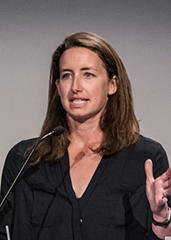The benefits
“Creating a visual or physical manifestation of an idea” helps students’ thought patterns become less rigid. In the process, Panzano finds that students develop analytical strategies applicable to other courses. Moreover, in the collaborative and flexible studio setting, they see classmates as fellow learners, not competitors.
Student projects: abstract terms to physical form
|

|

|
|
“Weaving” (paper)
|
“Packing” (chipboard)
|
The challenges
A design studio workshop—where students use sophisticated equipment (such as 3D printers and laser cutters), receive individualized feedback from instructors, and learn with and from each other—is resource- and time-intensive, and thus hard to scale. Panzano experimented with having a 1:12 instructor to student ratio, and concluded it was too large; her ideal is 1:10.
Takeaways and best practices
-
Leverage constraints to promote awareness and flexibility.
“Students grapple with their own ways of thinking as they grapple with what the material will or won’t do.” Paying attention to “the way paper wants to behave,” for example, forces students to consider more broadly: “what stays rigid, and what is flexible? What’s possible, and what do you have to let go of?”
-
Bridge to other disciplines.
Integrating verbal analysis with physical making, Panzano requires students to reflect on what they are doing and why; this fosters “the management of complexity, which translates to almost any subject.” As a student is working, Panzano might ask, “if this were an essay, what might be the thesis statement to track in greater specificity here?” These parallels show students they’re able to “explore raw materials and extract a repeatable process; they can diagram an idea, or represent cell structures, through visual means in ways they couldn’t before.”
-
Accept a range of options in social learning.
Panzano’s students create projects individually, but train on techniques and share equipment as a group. In “Desk Crit” mode, Panzano rotates among students, talking with each about their ideas. Other students can opt to listen in on these interchanges, and Panzano periodically raises generalizable lessons to the group. Competition is minimal because students learn from each other’s questions and strategies. In this “oscillation between self and others,” students choose the balance of collaborative and solitary work that’s right for them.
Bottom line
By working withinmaterial constraints, generating new options, and learning together, students’ perspectives are transformed. “This process is a micro-version of translating observations of the world into the world.”
 In her Transformations course, Assistant Professor of Architecture Megan Panzano uses architectural design methods and concepts, and a workshop approach for giving feedback, to engage undergraduates from a wide range of concentrations. When students translate abstract ideas into physical form through a variety of materials and fabrication techniques (see photos below), they confront limits, question assumptions, and expand their problem-solving capacity.
In her Transformations course, Assistant Professor of Architecture Megan Panzano uses architectural design methods and concepts, and a workshop approach for giving feedback, to engage undergraduates from a wide range of concentrations. When students translate abstract ideas into physical form through a variety of materials and fabrication techniques (see photos below), they confront limits, question assumptions, and expand their problem-solving capacity.


